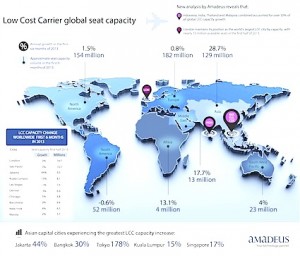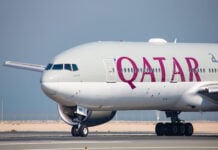New analysis from Amadeus’s Air Traffic solution reveals that low-cost carriers (LCCs) are showing significant confidence in their potential with an overall global increase in seat capacity of 6.8% in the first six months of 2013 compared to the same period in 2012. The analysis paints a picture of strong capacity growth across Asia and the Middle East with only modest increases across Europe and North America. 
Asia: Southern Asian Countries Fuel Boom
Low-cost carriers in Indonesia (capacity up by 12.3 million seats), India (capacity up by 3.0 million seats), Thailand (capacity up by 2.0 million seats) and Malaysia (capacity up by 1.8 million) were responsible for half of total, global, LCC capacity growth.
Asia showed the strongest growth rates of any region with a 28% overall increase to reach 129 million departing LCC seats in the first six months of 2013. When capital cities are examined, it is evident that capacity increases are being driven by emerging Asian nations.
Jakarta saw the strongest absolute LCC capacity growth of any capital, increasing by 2.8 million seats or 44%, closely followed by Bangkok, up 1.2 million seats or 30%. In addition, the heavily developed Tokyo market also saw a significant increase in LCC seat capacity, which suggests the traditional focus on full service, could be changing.
Europe: a Divided Landscape
Europe’s 0.8% overall LCC capacity growth masks a far more complex picture: across much of Southern Europe LCCs have reduced capacity, with Madrid seeing a fall in LCC departing seat capacity of 27%, the highest of any capital city in the region. Athens and Rome also saw significant percentage decreases.
This picture contrasts sharply with the situation in much of Eastern and Northern Europe where Warsaw witnessed an enormous jump in LCC capacity, up 63% year-on-year and now representing 27% of total departing capacity from the city. Istanbul and Copenhagen also saw LCC capacity increase sharply.
London Maintains Position as World’s Leading City for LCCs
On a global basis, London’s LCC seat capacity is by far the largest of any city with nearly 15 million available LCC seats. That is roughly 1.5 times the number of available seats at the next largest LCC city, Sao Paulo. However, the rates of growth occurring at Jakarta (44%) and Kuala Lumpur (15%) suggest the third and fourth placed cities may move up the top 10 ranking over coming years.
Alexandre Jorre, LCC specialist, Amadeus, said: “We see a natural boom in LCC capacity across Asia, where point-to-point air travel is largely underserved. However, across the mature markets of Europe and North America capacity is constrained, which may explain why some LCCs are considering new approaches to secure future growth.
“With a 25% year-on-year rise over the first half of 2013, LCC bookings in Amadeus are growing significantly, which is a very encouraging sign that our ability to adapt to LCC distribution needs is proving attractive to both travel agents and airlines. LCCs are seizing the opportunity we offer to penetrate the high-yield business travel market and expand into new regions where they have limited brand presence. To maximise these benefits, we keep innovating, as demonstrated by the new range of light ticketing enhancements just implemented for easyJet, which keep it simple for LCCs and make it far more efficient for agents to book and service LCCs.”
Pascal Clement, Head of Travel Intelligence, Amadeus, added: “Understanding how capacity trends are changing at a detailed level is fundamental to the planning process for both airlines and airports. Deploying effective data analysis tools that can seek meaning among huge volumes of data can give companies the edge.”
Amadeus Air Traffic is part of Amadeus’s Travel Intelligence Portfolio of solutions. Based on capacity and other data sources, Amadeus Air Traffic can calculate estimates for total air passenger volume for any Origin and Destination (O&D) worldwide, including those dominated by low-cost carriers. This means airlines can plan and develop networks that respond to true passenger air traffic and meet a clear need in the market based on complete O&D data.




